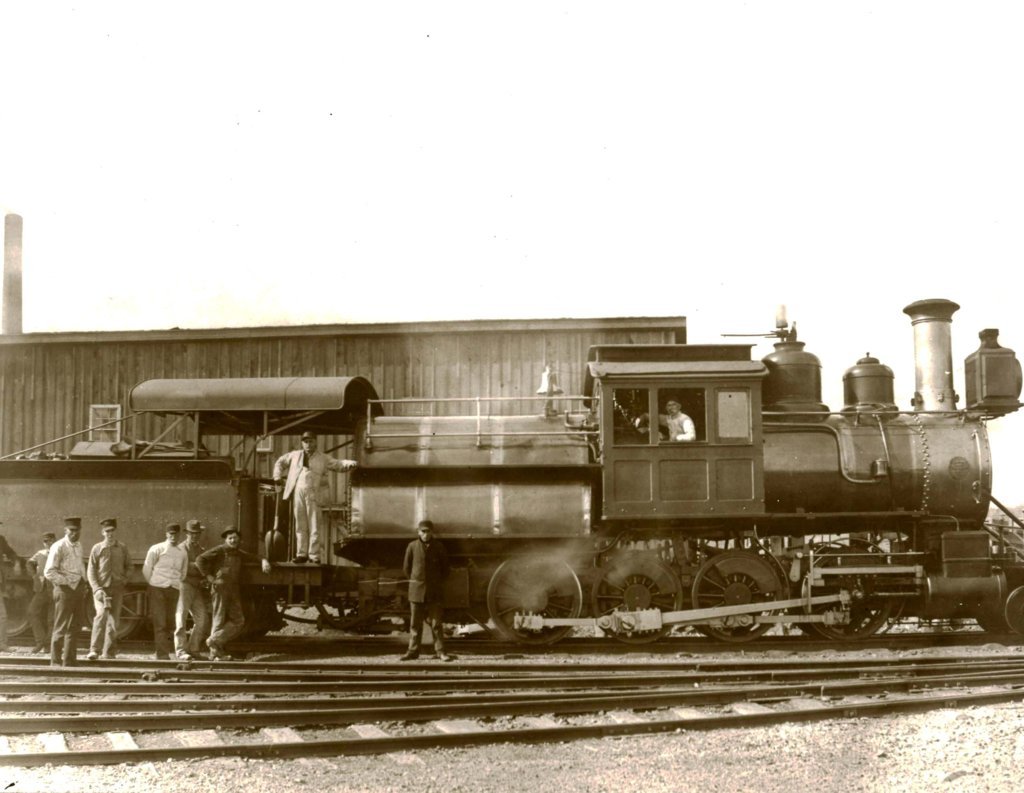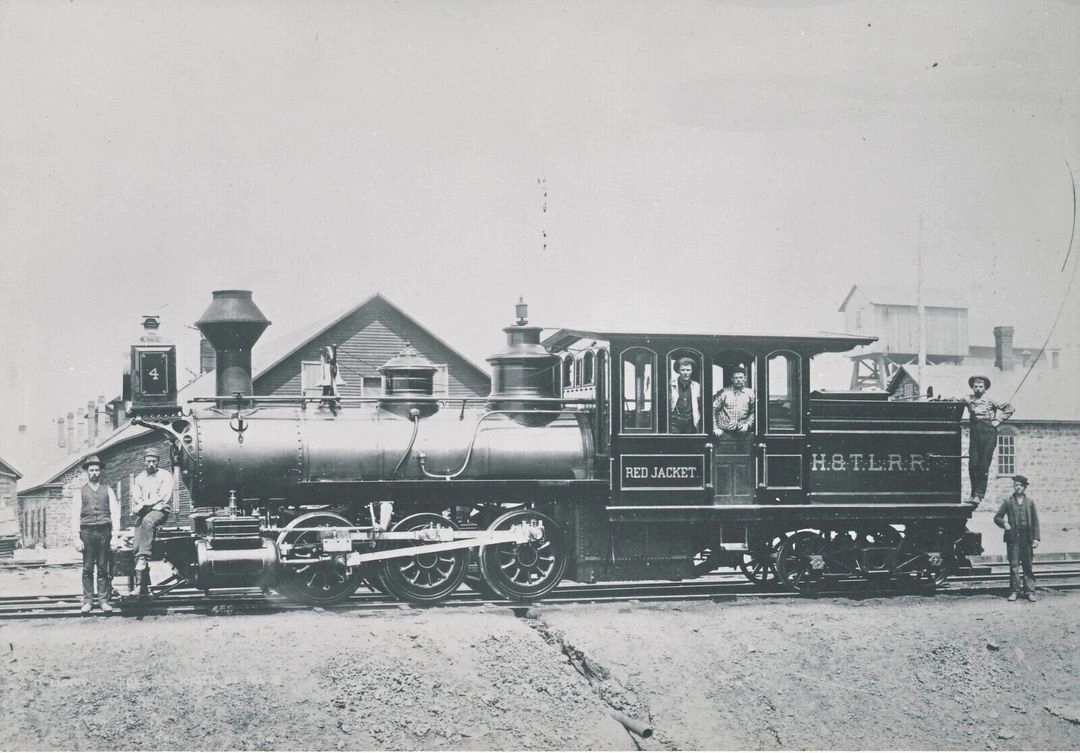- Details
- Hits: 4856
Railroad: Hecla and Torch Lake Railroad Company
The Hecla & Torch Lake railroad was owned by the Calumet & Hecla mining company. It was organized in 1868 around the mines near Red Jacket and Calumet and extending to the C&H mills near the town of Lake Linden on Torch Lake. The line converted to a common carrier railroad in 1900 and used both narrow and standard gauge tracks. This line continued to operate until the 1960's.
During early years of operation, the H&TL operated in conjunction with the Hecla Incline railroad for the last 7/8 mile to the Mill. H&TL trains would operate backwards, from the mines to the mill, with approximately 20 loaded cars, followed by the locomotive, which would likely be used to brake the train. At the start of the incline, the train would be broken into 5-car segments for the incline. [MIN-2022-Sp]
The C&H also built and owned the Trap Rock Valley railroad, which ran from their mills near Lake Linden northeast to the newer mines in Keweenaw County. This railroad, which was operated as part of the H&TL, is listed separately in the "Railroads In History" section.
Built → Hecla and Torch Lake Railroad → Abandoned
Built: 1868
Operated: 103 years.
Became: Private railroad, date unknown. Closed in 1960's upon closure of mines.
Reference: [MRRC]
Notes
This was an unusual 4' 1" gauge line built for the purpose of bringing iron ore from mines near Calumet to stamp mills near Torch Lake. Owned by the Calumet & Hecla mining company, but they reportedly used standard gauge rails as well.
Most of the H&TL was converted to standard gauge by 1907, but some portions continued along Torch Lake until the 1920's. [MIS-2004-Q2]
One of the H&TL locomotives is restored and presently operates on the Greenfield Village Railroad in Dearborn.

 Photo Info: Top, a C&H "camelback" locomotive near the mines in Calumet around 1900. Charlie Whipp collection]. 2nd photo, H&TL No. 4, named the "Red Jacket" poses for a photo at Calumet.
Photo Info: Top, a C&H "camelback" locomotive near the mines in Calumet around 1900. Charlie Whipp collection]. 2nd photo, H&TL No. 4, named the "Red Jacket" poses for a photo at Calumet.
Time Line
1867. Mid-October. The railroad's first locomotive arrived at the Hancock dock from the Vulcan Iron Works of Buffalo, New York. The locomotive arrived with a gauge of 49", rather than the 50" gauge ordered. The gauge of the road and existing cars were changed to 49". [MIN-2022-S]
1867. The railroad is completed from the mines to a point about one mile west of the Torch Lake mills. The remaining distance was traversed via a double track incline railroad with a head house. [MIN-2022-S]
1868. The incline is completed to the mills. [MIN-2022-S]
1868. The H&TL begins operation with one locomotive, one snowplow and fifty rock cars.
1874. May. A man was found dead in a pool of water on the Hecla & Torch Lake Railroad near the crossing of the county road. He had apparently fallen head first from the road. The body was frozen and quite hard to move it. Many felt he was intoxicated, fell, and suffocated in the water. The coroner's jury returned that he had committed suicide. [DFP-1874-0509]
1855. A new route at the end of the railroad along Torch Lake was planned, which was longer and reduced the grade so that locomotives could bring rock all of the way to the mill without the Incline railroad. [CRR]
1893. SNAPSHOT. The H&TL has 10.7 miles of railroad, with nine locomotives and 400 cars. Most of the line is 60# rail. The railroad also had a short track connecting the mills with the smelting works. [CRR]
1899. The H&TL extends a branch line from Lake Linden north around the north side of Torch Lake to reach a sawmill. The line was complete in 1900. [CRR]
1900. This line is converted from a common carrier railroad to a private industrial railroad. [MRL]
1902. 4' 1" gauge constructed with 60-70 lb. steel rail. No passenger stations along the line with the road used exclusively for handling of copper rock and freight of the C&H mining company. The company has 7.5 miles of road. [MCR-1903]
1903. SNAPSHOT. The H&TL employes 10 engineers, 10 firemen, 6 conductors and 22 brakemen, as well as 40 laborers (mostly section hands), 10 yardmen and 34 shop men. Their track is fenced. They owned 14 locomotives, one 8-wheel passenger car (likely a pay car), 32 flat and side board cars, 4 box cars, 57 stock cars, 80 platform cars, 639 ore cars and 3 conductors' way cars. Only four locomotives are equipped with power brakes. In 1903 they transported 1.7 million tons of rock, 165,000 tons of bituminous coal, 36,500 tons of lumber and logs, and a few other categories such as castings, machinery and cement. [MCR-1904]
1903. The H&TL report that their cars are not equipped with automatic couplers but have "safety" couplers made by a company known as "Childs". They mention that cars couple after "deadwood meets", allowing to danger to trainmen in making or unmaking trains. [MCR-1904]
1904. A plan is in contemplation for the extensive electrification of the Calumet I& Hecla property. It embraces enlargement of the electric Generating plant at Lake Linden and the conveying of the energy by wires to calumet for use throughout the property. [DFP-1904-0622]. Editor's note: The railroad was never electrified.
1906. The company begins to operate regularly at night do to increased rock tonnage. The company begins to change to standard gauge by adding a third rail. Completed in 1910. [CRR]
1912. Automatic bells and gates are installed at all major highway crossings. [CRR]
1921. April. Railroad operations are greatly curtailed when mines close due to a post-war recession. Mining resumed in 1921. [CRR]
1925. September. The Calumet & Hecla Consolidated Copper corporation has taken over its recently completed railroad (Trap Rock Valley railroad) from Ahmeek to Lake Linden, and is now hauling its own rock. The Mineral Range had previously hauled this rock. The article notes that the only other mine in southern Keweenaw County is the Mohawk railroad, which is cared for by the Copper Range railroad. [BCE-1925-0916]
1928. The nine miles of the Keweenaw Central railroad out of Calumet Junction to the northeast is operated by the Copper Range railroad. The remaining seven miles were optioned to the C&H. [CRR]
1948. Two Baldwin diesel locomotives, 1,000 horsepower, arrive to replace aging steam locomotives. One was used on the Trap Rock Valley line and the other to switch the Calumet mines to the Ahmeek mill. Other, less powerful GE locomotives would be used to switch the smelter. [CRR]
1948. C&H railroads received 1,713 car loads from outside connections (DSS&A) and shipped out 1,464 car loads. Most of this was copper rock and coal. Ship cargoes from 26 ships landed at the company dock on Torch Lake. [CRR]
1968. April 30. C&H merges into Universal Oil Products. By August the UOP shuts down due to a strike. The company never recovers.
1971. Mining railway being removed. Salvagers have started to remove the rails of the Calumet Hecla Mining Company’s industrial railway, which once carried carried millions of tons of copper ore in Michigan’s Upper Peninsula. The line, with branches and spurs, is 45 miles in length (including the Trap Rock Valley railroad) and stretches from Tamarack Mills to Lake Linden and then northerly to Seneca in Keweenaw County. Removal of the line was caused by a strike which took effect Aug. 21, 1968 against the Universal Oil Products Co., the C&H parent corporation.
See Also
Bibliography
The following sources are utilized in this website. [SOURCE-YEAR-MMDD-PG]:
- [AAB| = All Aboard!, by Willis Dunbar, Eerdmans Publishing, Grand Rapids ©1969.
- [AAN] = Alpena Argus newspaper.
- [AARQJ] = American Association of Railroads Quiz Jr. pamphlet. © 1956
- [AATHA] = Ann Arbor Railroad Technical and Historical Association newsletter "The Double A"
- [AB] = Information provided at Michigan History Conference from Andrew Bailey, Port Huron, MI

